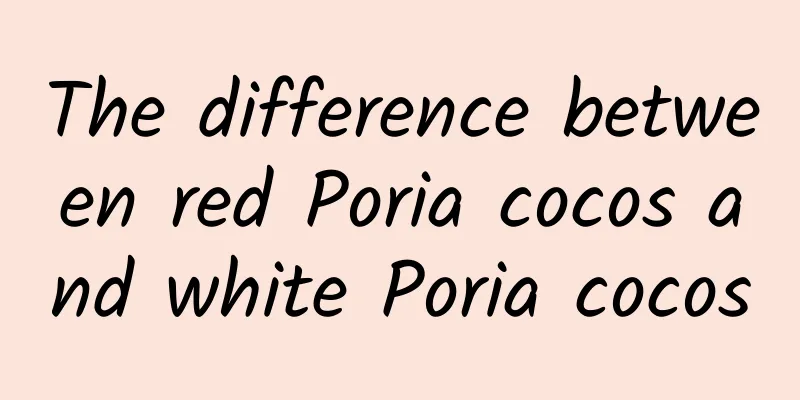The difference between red Poria cocos and white Poria cocos

|
Red Poria cocos, also known as wild Poria cocos, is a very common Chinese medicinal material. It has a nourishing effect on the human body. Eating red Poria cocos can improve the body's health. However, there are many types of Poria cocos, including wild Poria cocos and red Poria cocos. Each different type of Poria cocos has different nourishing effects on the body. Poria cocos can be used to stew soup, and Poria cocos can also be used as medicine. So what are the differences between red Poria cocos and white Poria cocos? Smilax glabra is a climbing shrub mainly used for syphilis, clearing away heat and dampness. The rhizome is tuberous, with obvious tubercles and numerous fibrous roots. The stem is thornless. Simple leaves are alternate; leathery, lanceolate to elliptic-lanceolate, 6-20 cm long, 1.2-5 cm wide, acuminate at the apex, rounded at the base, entire, often powdered on the underside, with 3-5 basal veins; petiole 1-2 cm long, slightly wing-shaped, with spreading sheaths near the base, the apex of the sheaths often turning into 2 tendrils. Flowers are unisexual and dioecious; umbels are axillary with extremely short peduncles; pedicels are slender with numerous persistent triangular bracteoles at the base; flowers are small, white, about 4 mm in diameter; perianth has 6 lobes in 2 whorls; male flowers have 6 stamens, filaments are shorter than anthers, and the reduced pistils lack them; the reduced stamens of female flowers are linear, the ovary is superior, 3-chambered, and the stigma is 3-branched and slightly recurved. The berries are spherical, 6 to 8 mm in diameter, and red. Flowering period is from July to August. The fruiting period is from September to October. White Poria cocos strengthens the spleen and promotes diuresis. It is mainly used to strengthen the spleen, treat stomach problems and edema. Both are non-toxic and can be used externally without side effects. White Poria cocos is in blocks, while wild Poria cocos is cut into large pieces. There are two types, red and white. The red one is better. Cloud Poria cocos has the effect of strengthening the spleen and removing dampness. It is a fungus that parasitizes on the roots of pine trees. It is shaped like a sweet potato, with a dark brown skin and white or pink inside. Dried sclerotia of Poria cocos of the Polyporaceae family. It is dug up from July to September, the soil is removed, and it is piled up to "sweat". Then it is spread out in the sun until the surface is dry, and then it is "sweated" again. This is repeated several times until wrinkles appear. After most of the internal moisture is lost, it is dried in the shade and is called Poria cocos. Or fresh Poria cocos can be cut into different parts and dried in the shade, which are called Poria cocos skin, red Poria cocos, and Poria cocos slices respectively. [Distribution of Origin] It is mainly produced in Hubei, Anhui, Henan, Yunnan, Guizhou, Sichuan and other provinces, and is now cultivated in large quantities in many areas. [Characteristics of medicinal materials] Poria cocos are spherical, oval or irregular in shape, with varying sizes. The outer skin is thin and rough, brown to dark brown, with obvious raised wrinkles, and white hyphae are occasionally seen on the surface. It is heavy, solid, not easy to break, with an uneven cross-section, granular, and some with cracks; the outer layer is light brown, and the pieces are often processed into red Poria; the inside is white, and a few are light red, and the pieces are processed into white Poria or Poria slices. The differences between red Poria cocos and white Poria cocos are what we introduced above. White Poria cocos and red Poria cocos have the same good effects on the body. If you don’t know, you can try it to see which kind of Poria cocos is good for your body. Then, you can eat the healthiest and most beneficial Poria cocos for your body. When eating Poria cocos, you must also pay attention to the most critical point, which is the dosage of the medicine. |
<<: What are the prescriptions for longevity?
Recommend
One pound of durian contains two pounds of "carbon". How do agricultural scientists measure carbon emissions reduction for domestic durian?
Xinhua News Agency Haikou, July 21 (Reporter Chen...
The Soviet Union’s dream of “digging through” the earth stopped at 12,262 meters. How far can we go?
"Going to heaven and into earth" has be...
The efficacy of wild black wolfberry soaked in water
We all know that drinking black wolfberry soaked ...
Is a zebra white with black stripes, or black with white stripes?
This article was reviewed by Zhao Xumao, a young ...
How far are we from the virtual world in "The Matrix"?
Will we be able to place ourselves in various fan...
Academician Ouyang Ziyuan: The moon is already "dead", why do we still need to explore it?
Have you ever thought about this question: Will a...
The efficacy and function of ground orange
Many people choose ditang because of its high-val...
The efficacy and function of Eight Immortals Crossing the Sea
Eight Immortals Crossing the Sea is a traditional...
What would happen to us if we could no longer feel pain?
In life, we are bound to get hurt sometimes. Expe...
The efficacy and function of Croton glomerata
Many people are very familiar with Croton tiglium...
Where to watch whales in China?
This journey is purely fictitious But the knowled...
These 10 eating habits are quietly stealing your life! Many people don’t know it yet
Does your day start like this: rushing out in the...
The efficacy and function of money tree roots
As a traditional Chinese medicine, the root of th...
The efficacy and function of Chinese yam vine
Do you know about yam vine? It is a common medici...
Is it possible to transform a cemetery into a solar power plant? | Environmental Speaker
Hello everyone, this is the 7th issue of the Envi...









